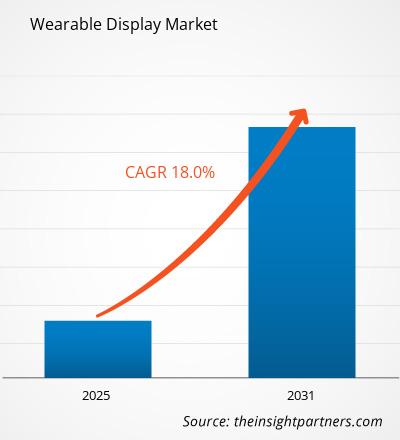A wearable display technology provides a visual interface between computing platforms such as smartphones and laptops and human being. Technological advancements have led to a rise in demand for innovative products, thereby contributing significantly to the wearable display technology market growth.
The wearable display technology came to light in 2000, at the time when Bluetooth headsets were launched. Further, in 2013, the unveiling of the Google Glass, an optical head-mounted display with augmented reality (AR) and virtual reality (VR) features for capturing images, paved the way for the flourishment of this display technology.
Most of the key IT and technology companies, such as Amazon and Google, have shown interest in wearable display technology and introduced their version of displays. Following are the milestones that have supported the wearable display technology market:
- Proliferation of wireless internet connectivity
- Introduction of smart devices
- Growth of HD display resolution technology
- Advancements in AR and VR
The wearable display technology market is expected to pace up further with the use of smart wearable devices, and the rising adoption of AR and VR technologies in headsets, mobile devices, and flexible OLED displays. The wearable display technology benefits users through better viewing angles and sharp color contrast, which maximize the interest of viewers, especially the youth. Furthermore, there has been the introduction of IoT and 5G technology in the market, and the combination of these technologies with wearable displays will help the display manufacturers in further enhancing the user experience in the coming years. As a result, the wearable display technology market is expected to grow at a CAGR of 18% during the forecast period of 2021-2031.
The primary market for wearable display technology is the wearable devices, which are estimated to reach more than 550 million device shipments annually by the end of 2021. Of these, more than 80–85 million are likely to be smart glasses. Enterprises from many industries are taking initiatives to promote the use of wearable/smart technology among their employees on a daily basis. The airlines industry is one such industry, wherein the use of wearable devices is recommended for effective peer-to-peer communication, security, customer data, flight operations, and aircraft maintenance. The medical industry is also encouraging the use of wearable display technology in patient checklists and patient medical history maintenance, documentation, and in emergency cases. In the automotive sector, wearable display products are being used for easing communications, production line checks, remote diagnostics, and training. Other industries such as customer service, military, heavy equipment, and consumer electronics are also encouraging the use of this display technology. These wearable displays can function as a phone whenever required by users.
The gadgets that are enabled with the wearable display technology have revolutionized the overall IT sector, which is another factor contributing to the growth of the wearable display Technology Market. This technology has also been having a revolutionary impact on the education, gaming, fashion, media, finance, and healthcare sectors.
Many companies have now entered in the market of mobile applications that are compatible with these wearable devices, as well as features such as answering voice commands, tapping, and gaming, which significantly impact user engagement.
The wearable display technology market has undergone several significant developments, and a few of these have been mentioned below:
- In September 2021, Supersapiens launched a new wearable display that provides real-time data. This first Supersapiens glucose display wearable designed specifically for athletes.
- In January 2022, TCL announced that the company is preparing to launch the second iteration of the wearable personal display it released in a limited supply in 2021. Version 2 called NxtWear Air offers the same secondary-display-in-a-pair-of-glasses function as the original version, but it has been made 30% lighter in weight.
- In December 2019, BoAt launched its new smartwatch with an HD AMOLED display.
The wearable display technology market is characterized by the presence of both large and startup companies, engaged in launching new products. The new entrants are entering in the market with investments or with partnerships. A few of the major players in the market include Vufine, Samsung Electronics, LG Display, Lumus, Truly Semiconductors, AU Optronics, Japan Display and Hewlett Packard Enterprise Development LP.
Wearable Display Report Scope
| Report Attribute | Details |
|---|---|
| Market size in 2024 | US$ XX million |
| Market Size by 2031 | US$ XX Million |
| Global CAGR (2025 - 2031) | 18% |
| Historical Data | 2021-2023 |
| Forecast period | 2025-2031 |
| Regions and Countries Covered | North America
|
| Market leaders and key company profiles |
- Historical Analysis (2 Years), Base Year, Forecast (7 Years) with CAGR
- PEST and SWOT Analysis
- Market Size Value / Volume - Global, Regional, Country
- Industry and Competitive Landscape
- Excel Dataset



Report Coverage
Revenue forecast, Company Analysis, Industry landscape, Growth factors, and Trends

Segment Covered
This text is related
to segments covered.

Regional Scope
North America, Europe, Asia Pacific, Middle East & Africa, South & Central America

Country Scope
This text is related
to country scope.
Trends and growth analysis reports related to Electronics and Semiconductor : READ MORE..
- Samsung Electronics
- LG
- AU Optronics
- HPE Development LP
- Intellisense Systems
- WaveOptics
- Googles
- Ostendo
- Westunitis
- EEnovate Technology

 Get Free Sample For
Get Free Sample For